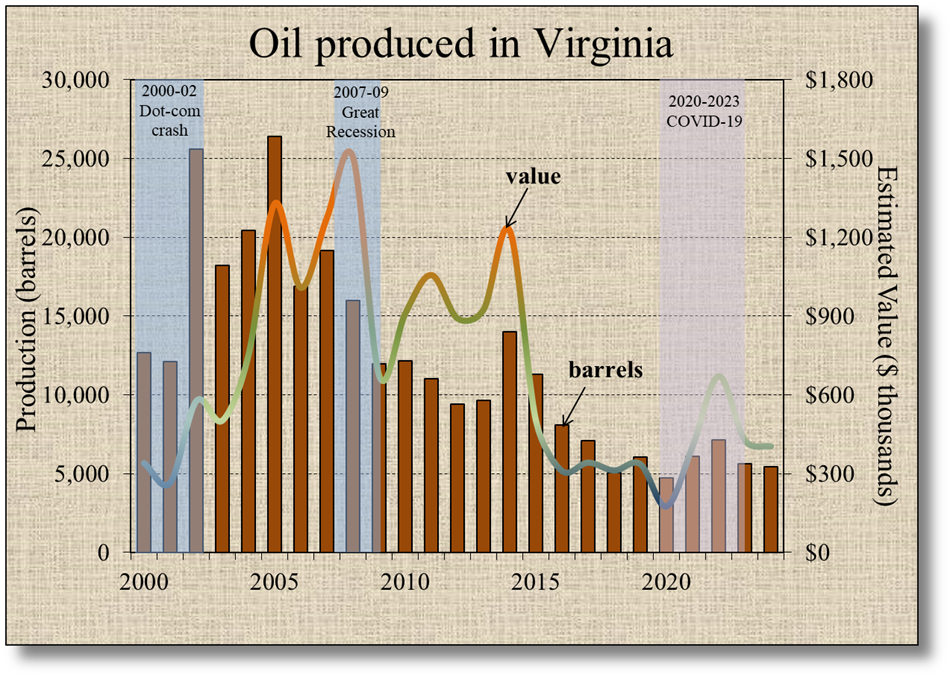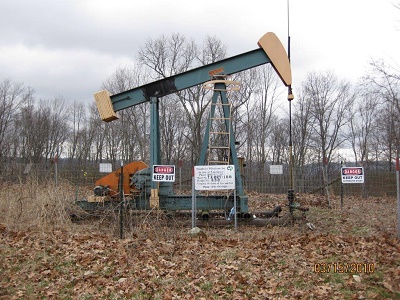Virginia's gas and oil industry reported the production of 5,609 barrels of crude oil in 2024, down about 3.4 percent from the production reported in 2023. The estimated value is $403 thousand.

Oil production and value in Virginia
The estimated value is calculated using the average domestic crude oil first purchase price per barrel reported by the U.S. Energy Information Administration (EIA).
Oil is a fossil fuel mixture of hydrocarbons that is recovered in Virginia in two main forms, crude oil and condensate. Crude oil is produced at the wellhead in liquid form at atmospheric pressures and temperatures. Condensate is recovered as a byproduct of natural gas production. The major uses for petroleum products are gasoline, diesel fuel, fuel oil (often used for heating homes), propane, aviation fuel, petrochemical feedstocks, kerosene, lubricants, waxes, and asphalt.
Year of first production in Virginia: 1942
Location of first production: Lee County
Number of wells producing oil in Virginia (including those that also produce gas): 47
Counties in Virginia where oil is currently produced: Lee, Wise
Number of companies: 4
Quantity produced in 2024: 5,417 barrels
Estimated market value in 2024: $403 thousand
Total cumulative production (Since 1951): about 993 thousand barrels

Oil well, Lee County
In the past, crude oil has been produced in Buchanan, Lee, Russell and Wise counties in southwest Virginia. Oil production in Virginia reached its peak level in 1983, with 65,400 barrels produced during that year. Most of the past production in Virginia occurred in the Ben Hur-Fleenortown and Rose Hill fields in Lee County. The oil is produced from several zones within the fractured Middle Ordovician-age Trenton Limestone of the Appalachian Basin. The Trenton Limestone occurs as a structurally folded unit beneath the Cumberland Overthrust Block in the Appalachian Plateaus Province. The gas wells that also produce oil in Lee and Wise counties produce from the Lower Mississippian-age Weir sandstone that is within the Price Formation.
Selected References:
Averitt, P., 1941, Early Grove gas field, Scott and Washington counties, Virginia: Virginia Division of Mineral Resources Bulletin 056, 50 p.
Bartholomew, M.J., Schultz, A.P., Milici, R.C., 1980, Geologic structure and hydrocarbon potential along the Saltville and Pulaski Thrusts in Southwestern Virginia and Northeastern Tennessee: Virginia Division of Mineral Resources Publication 023, six folded 40 x 26-inch black and white sheets.
Butts, C., 1927, Oil and gas possibilities at Early Grove, Scott County, Virginia: Virginia Geological Survey Bulletin 027, 18 p.
Gilmer, Amy K., Enomoto, Catherine B., Lovett, James A., and Spears, David B., 2005, Mineral and Fossil Fuel Production in Virginia (1999-2003): Virginia Division of Mineral Resource Open File Report 05-04, 77 p.
Gathright, T.M., Jr., 1981, Lineament and fracture trace analysis and its application to oil exploration in Lee County, Virginia: Virginia Division of Mineral Resources Publication 028, 40 p.
LeVan, D. C., and Rader, E. K., 1983, Relationship of Stratigraphy to Occurrences of Oil and Gas in Western Virginia; Virginia Division of Mineral Resources Publication 43, one sheet.
Miller, R. L., and Fuller, J. O., 1954, Geology and Oil Resources of the Rose Hill District – the Fenster Area of the Cumberland Overthrust Block – Lee County, Virginia; Virginia Division of Mineral Resources Bulletin 71, 383 p., 50 pls., 17 figs., 17 tables, 11 geologic sections.
Nolde, J. E., 1992, Oil and Gas Well Data and Geology, Lee County, Virginia; Virginia Division of Mineral Resources Publication 113, 13 p., 2 maps, scale 1:50,000.
Nolde, J.E., 1996, Geology, natural gas, oil, and other mineral resources of Wise County, Virginia: Virginia Division of Mineral Resources Publication 144, 38 p.
Additional Resources:
Virginia Division of Gas and Oil
U.S. Energy Information Administration
Virginia Center for Coal and Energy Research at Virginia Tech
